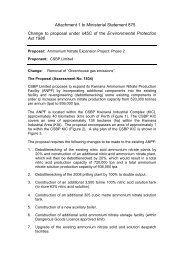Inland Waters of the Pilbara, Western Australia - Environmental ...
Inland Waters of the Pilbara, Western Australia - Environmental ...
Inland Waters of the Pilbara, Western Australia - Environmental ...
You also want an ePaper? Increase the reach of your titles
YUMPU automatically turns print PDFs into web optimized ePapers that Google loves.
Small crustaceans (Cyzicus sp) were quite abundant in <strong>the</strong> sediments <strong>of</strong> Coondiner Pool. It<br />
is recommended that future surveys sample <strong>the</strong> sediments as knowledge <strong>of</strong> mollusc and<br />
crustacean populations may be <strong>of</strong> assistance in classifying water body types (McMichael,<br />
1967).<br />
3.6.2 FISH<br />
The best-developed fish assemblages were found in <strong>the</strong> relatively clear waters <strong>of</strong> wetland<br />
types 1 and 3 (Table 10) ie those which have permanent or semi-permanent water supplies.<br />
No fishes were recorded from <strong>the</strong> claypan areas, except for Hooley Creek #1 (site 20). but<br />
limited searching revealed some crustaceans (Table 10).<br />
The freshwater herring (Nematalosa erebd is susceptible to eutrophic conditions and will be<br />
<strong>the</strong> first species lost when water quality deteriorates (All en, 1982). This makes it a useful<br />
indicator <strong>of</strong> water quality. During this study large numbers were found dead in Lockyers<br />
Gorge, bleeding from <strong>the</strong> gills; a possible symptom <strong>of</strong> 0 2<br />
starvation. Cohabitant grunter<br />
species (Teraponidae) and rainbow fish (Melanotaeniidae) were, however, showing no signs<br />
<strong>of</strong> stress. Dissolved oxygen levels measured at <strong>the</strong> time were close to saturation (6.4 mg.L - 1,<br />
site 73, Table 3) and significantly higher than recorded in May 1976 (3.5 mg.L- 1 at 0.1 m and<br />
2.1 mg.L- 1 on <strong>the</strong> bottom). It is possible that <strong>the</strong> fish were stressed as a result <strong>of</strong> increased<br />
biological oxygen demand at night.<br />
3.7 AVIFAUNA<br />
Results <strong>of</strong> <strong>the</strong> avifaunal sightings are presented in Table 11. The most diverse site was<br />
Coondiner Pool, a shallow semi-permanent claypan, affording a good feeding ground for<br />
wading birds with abundant crustaceans (see above). Second most diverse were <strong>the</strong> spring<br />
systems, and <strong>the</strong> semi-permanent claypan at Hooley Creek. Insufficient time was available<br />
to make a detailed study and hence diversity may be underestimated and bia_sed.<br />
The majority <strong>of</strong> birds sighted were nomadic or migratory, reflecting <strong>the</strong> intermittency <strong>of</strong><br />
suitable water bird habitats within <strong>the</strong> arid <strong>Pilbara</strong>. Waterfowl are opportunistic in <strong>the</strong>ir<br />
breeding strategies and may disperse over wide areas during good seasons. Large<br />
populatlons <strong>of</strong> water birds such as pelicans, spoonbills and swans are known to breed in <strong>the</strong><br />
Fortescue marshes during a good wet season, but this did not occur in 1982/83.<br />
During seasons <strong>of</strong> poor rainfall, <strong>the</strong> wetlands with permanent and semi-permanent surface<br />
water come under increased pressure from large concentrations <strong>of</strong> waterbirds.<br />
3.8 LAND USE<br />
Pastoral, mining and recreational activities are <strong>the</strong> dominant land uses affecting <strong>Pilbara</strong><br />
wetlands. The wetland sites examined that were reserved under <strong>the</strong> Land Act were within<br />
<strong>the</strong> Millstream-Chichester National Park (Minnorinna Pool) and within reserves<br />
designated for <strong>the</strong> purposes <strong>of</strong> watering stock and as resting places for travellers (Hooley<br />
Creek Reserve 5515, Gnalka Gnoona Pool Reserve 1328). The majority <strong>of</strong> sites however are<br />
located within pastoral leases. and as such are managed by <strong>the</strong> lessee as a source <strong>of</strong> water<br />
and feed for stock.<br />
The widespread system <strong>of</strong> bores and wells installed by <strong>the</strong> pastoralists has allowed <strong>the</strong>m to<br />
carry more stock over a wider range than was previously possible. Naturally-occurring<br />
water sources are also utilized, as <strong>the</strong>y supply not only water, but provide conditions<br />
favourable for <strong>the</strong> growth <strong>of</strong> forage grasses.<br />
Cenchrus ciliaris (buffel grass) and Aeroajavanica (kapok), both exotic species, have been<br />
introduced and actively spread by pastoralists to improve feed quality and availability. In<br />
many areas buffel grass has out-competed natural grasses, and, especially in <strong>the</strong> vicinity <strong>of</strong><br />
water, has become widespread over much <strong>of</strong> <strong>the</strong> <strong>Pilbara</strong>. Ho<strong>of</strong> prints and trampled<br />
vegetation were common sights around <strong>the</strong> wetlands surveyed. This disturbance is<br />
undoubtedly associated with erosion by wind and rain, due to a lack <strong>of</strong> ground cover and<br />
substrate instability. At certain sites. such as Yarri Spring on Roy Hill station. ground<br />
cover was almost non-existent because <strong>of</strong> poor rains and over-grazing by cattle.<br />
41


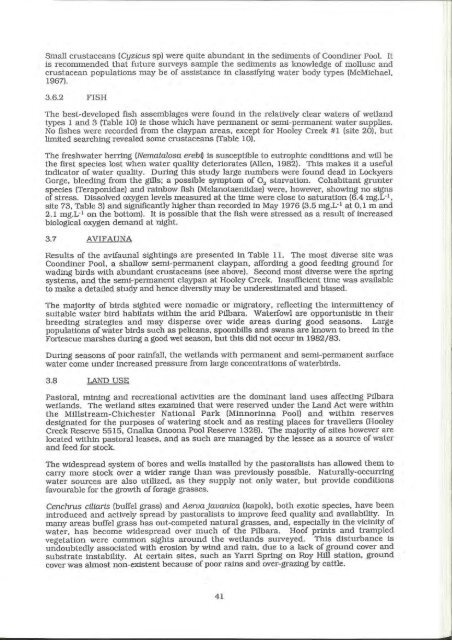
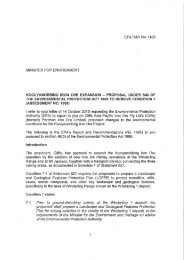
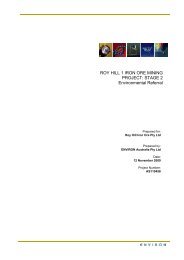

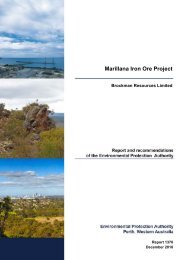
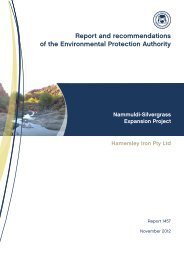
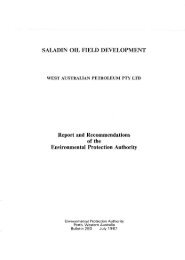
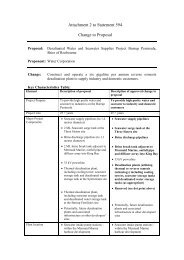
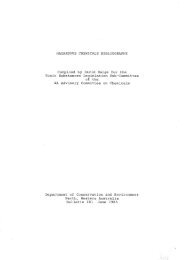
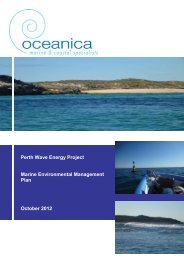
![[Project Title] - Environmental Protection Authority](https://img.yumpu.com/35475857/1/184x260/project-title-environmental-protection-authority.jpg?quality=85)

![[Project Title] - Environmental Protection Authority](https://img.yumpu.com/33147681/1/184x260/project-title-environmental-protection-authority.jpg?quality=85)
